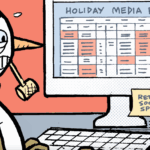Could curation tech help SSPs stand out from an increasingly commoditized crowd?
PubMatic feels well positioned to win as curation mania takes over programmatic, CEO Rajeev Goel told AdExchanger.
Although PubMatic’s past few quarters were marred by downward revisions to its revenue guidance – resulting in its stock price hitting a 12-month low after it reported Q4 earnings last week – curation has been a bright spot, Goel said.
Its curation product, Connect, grew by 140% year over year in Q4. (The company did not share from what base that growth came, but Goel said “it’s a pretty significant part of our business.”)
As the curation hype took hold, PubMatic has prioritized building capabilities for its curation partners, currently numbering 190.
“We focused on enabling the business model of curators, rather than on PubMatic as a curator,” Goel said.
He spoke to AdExchanger about the sell-side curation trend.
AdExchanger: What drives adoption of sell-side curation?
RAJEEV GOEL: Third-party cookies going away is one factor. But there’s an overall shift to sell-side targeting.
Targeting used to be done in the DSP. Now, privacy regulations prohibit the spread of data through the bidstream. Plus, there’s growing evidence that targeting is more efficient on the sell side.
Retail media is also a driver. A lot of retailers are sensitive data owners. They’re wary of sharing data on the buy side, because they don’t trust that their data is going to be used or protected in the right way.
Also, curators historically have been intermediary nodes in the supply chain. But with wide adoption of sellers.JSON and ads.txt, it’s more difficult for intermediaries to get on publisher websites. That’s another reason curation is taking off.
DSPs make a large portion of their revenue from data fees. How is it different when data sales are applied by the SSP instead?
We have our core SSP fee. And we also have a data fee in the curation transaction based on the curator’s fee. That fee is negotiated partner by partner.
My sense is that when we apply it on the sell side, the fees are lower than in the DSP. I’m hesitant to say that’s the case for all DSPs. But I hear advertisers and agencies feel like they’re overpaying with some DSPs.
Should publishers be concerned about fee transparency? Some publishers worry that curators may take an extra cut of the CPM after the DSP’s fee, but before the SSP is paid.
I don’t think that can happen, because the CPM the buyer pays is declared in the SSP when the curator sets up the deal.
Even if that weren’t the case, and the curator tried to take too much, then they wouldn’t win any auctions. Because most of the ecosystems work on net bidding, the only way the curator can win is if the net CPM to the publisher is higher than the alternative.
You could also argue that whatever fee the curator takes is the fair value of the data. And that the publisher can only be better off because it’s incremental demand that wouldn’t be there without the curation.
How can publishers tell if these curation fees represent fair value?
Our retail media partners ask us all the time: What should I charge for data? We give them guidance, but the market is what’s going to figure that out. Fortunately, there’s a very healthy market.
If you try to overcharge for data costs, you’re not going to win transactions. Now, if the curator wins, it means the publisher didn’t have a higher bid. So, should the publisher now be upset that the curator “took too much”? Or was that actually a reasonable amount?
People also sometimes forget that curation is work. We don’t just launch the campaign and let it run. There’s somebody optimizing the campaign and making sure it’s delivering on the advertiser’s performance hurdles. That work historically was done inside an agency.
So, the debate is a bit misplaced. Because back then, you got the contracted rate from the agency, and the agency was charging the advertiser for all of this curation, trading and optimization work. It’s not so different today.
Do publishers have any recourse if they think curators are taking advantage?
You can always push your floor price up. We respect publisher floor pricing, and we don’t have any different rules on floor pricing when it’s a curated data set or inventory. Obviously, if you set the floor too high, you’re not going to get anywhere.
What if publishers suspect their SSP isn’t honoring their pricing floors in curated deals?
The publisher ultimately has control, because they can opt out of curation. And, in theory, a publisher could enforce their floor price in whatever layer is downstream from the SSP. In their ad server or the bid wrapper, for example.
Does PubMatic opt publishers into curation by default?
We opt them in by default. If a publisher is coming to us, it’s looking for more yield, so we’re looking for incremental bits of revenue. But they can opt out.
Is there more that industry groups could do to standardize curation fees and give publishers more controls to opt out? Or is that best left to the market?
It should be left up to the market. There doesn’t need to be a standard on price floors, because there isn’t a standard for non-curated deals.
But we, as an SSP, can probably do a better job to educate publishers. That’s something we’re very focused on this year.
This interview has been edited and condensed.
For more articles featuring Rajeev Goel, click here.















